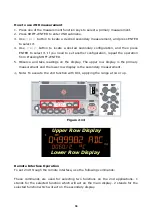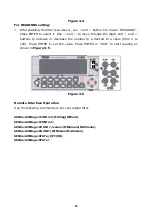
35
2.10 2ND Measurement
DL-1060 provides a secondary measurement function as users make a primary
measurement. By using 2nd function, users are able to make two measurements at
the same time. The
Table 2-2
below shows the available measurement functions for
each primary measurement on DL-1060.
Table 2-2
(Available 2ND functions on DL-1060)
2ND
Prim.
DCV DCI 2W 4W ACV ACI FREQ PER FREQ_C PER_C CAP TEMP TCO
DCV
-
△
-
-
○
-
○
○
-
-
-
-
○
DCI
△
-
-
-
△
○
○
○
○
○
-
-
○
2W
-
-
-
-
-
-
-
-
-
-
-
-
○
4W
-
-
-
-
-
-
-
-
-
-
-
-
○
ACV
○
△
-
-
-
-
○
○
-
-
-
-
○
ACI
-
○
-
-
-
-
-
-
○
○
-
-
○
FREQ
○
○
-
-
○
-
-
○
-
-
-
-
○
PER
○
○
-
-
○
-
○
-
-
-
-
-
○
FREQ_C
-
○
-
-
-
○
-
-
-
○
-
-
○
PER_C
-
○
-
-
-
○
-
-
○
-
-
-
○
CAP
-
-
-
-
-
-
-
-
-
-
-
-
○
TEMP
-
-
-
-
-
-
-
-
-
-
-
-
○
TCO
○
○
○
○
○
○
○
○
○
○
○
○
-
○:
Available
△
:
Not covered
-
:
Unavailable
※
△
:
This symbol indicates that the measured value is not covered by the specifications.
※
Note: To simultaneously measure the DCI & DCV from the same input source, you have to
use three leads. The voltage and current measurements must share the same common lead
at the LO terminal. However, this application will cause an inaccurate measurement due to
the leads combining with a small amount of internal resistance in the DMM and forming an
IR which directly and annoyingly affects the measurement. For instance, 30 m
Ω
of lead
resistance will cause approximate 90 mV error at 3 A.
When executing the 2nd function with voltage and current
measurements, do not connect the different votage at the LO terminal.
Connecting the short condition may damage your meter and EUT
(Equipment Under TEST), or cause possible fire or personal injury.
WARNING
!
















































